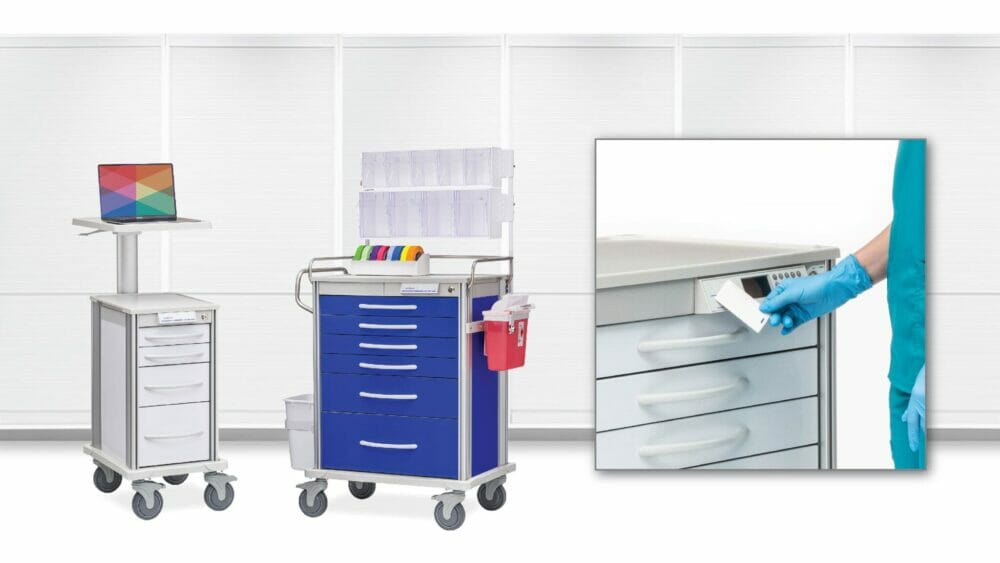
Mobile procedure carts have become part of the landscape in healthcare facilities.
Mobile carts help healthcare professionals provide fast, efficient, and safe patient care. A well-equipped mobile cart makes performing simple procedures at the bedside less stressful for the patient and can reduce patient transfers resulting in less confusion and fewer errors.
Stocked with the supplies needed to meet a specific medical need, some examples of mobile procedure carts include:
Procedure carts have drawers for supplies and may come with bins, workspaces, and rails for attaching larger equipment to the sides and front, such as trash bins, sharps containers, and IV poles.
For example, anesthesia carts, stocked for convenience, speed, and safety, provide the necessary supplies for anesthesia professionals to care for their patients during surgeries and procedures. Other procedure carts operate as all-in-one workstations and supply closets, allowing healthcare staff to remain at the bedside.
Here are three essential features that every mobile procedure cart should have. These features will ensure your purchase serves you well for years to come.
Adaptability
What is the one constant in healthcare? Change.
A configurable cart lends itself well to a changing healthcare landscape, such as when COVID-19 forced facilities to shut down entire units or convert existing units to COVID-care units.
Adjustable drawer dividers, optional accessory mounts, and attachable work surfaces can turn a standard cart into a mobile procedure cart or an anesthesia cart into an isolation cart.
Adaptability gives your mobile procedure carts longevity.
Hygienic Design
Each day in the U.S., 1 in 31 hospitalized patients is diagnosed with a healthcare-associated infection (HAI).
HAIs may result from organisms introduced during surgery or a procedure, an IV or catheter left in place for too long, or exposure to pathogens during routine hospital care.
Help reduce the risk of HAIs by choosing procedure carts that are easy to clean. Look for smooth surfaces, rounded corners, and sturdy materials that won’t chip or dent, reducing nooks and crannies that can harbor pathogens.
Some carts include antimicrobial work surfaces that can also help reduce the risk of infections.
Security Options
Procedure carts may contain medications, controlled substances, sharp instruments, and expensive medical devices. Stolen drugs and medical devices cost hospitals millions of dollars each year. Black market sales or misuse of stolen items can be dangerous and cause physical harm, or worse.
Facilities need to balance the security measures used to keep medications and supplies safe with providing authorized staff easy access to these same supplies. Security is essential, but timely medical care saves lives.
A key lock or simple key code only may be needed to secure an IV supply cart, but a pharmacy cart might require a more robust locking system. The option to upgrade to a keycode plus badge swipe entry system provides better security for sensitive supplies.
Tips for getting the most out of your mobile procedure carts
Stock consistently
If your facility has multiple carts that do the same job, like anesthesia carts or code carts, make sure each type of cart is configured and stocked the same. When a staff member works in a different area, make their job easier by providing mobile procedure carts set up the same as the carts they’re used to using.
Look for carts that are lightweight but sturdy
No one wants to struggle with a heavy, unwieldy cart when responding to an emergency or maneuvering around people and other equipment. And a cart should never be at risk of tipping.
Consider cart size
Procedure carts come in varying heights. Consider where and how the carts will be used.
A shorter cart may be stored under a counter or used as a workspace. Taller carts can be useful when staff stand to use the top work surface, or when floor space is limited. If floor space is at a premium, consider narrow carts that won’t be in the way of foot traffic.
Your mobile procedure carts should serve your staff instead of your staff serving their carts. Choose carts that are adaptable, easy to clean, and secure.

Cindy Blye
Content WriterCindy Blye, BSN, RN, CCM is a Registered Nurse and Certified Case Manager. She is an Alumni of West Virginia University School of Nursing (BSN), and a member of the Association of Health Care Journalists and The Authors Guild.
